Notes: Widnes South station opened as Widnes on 1 March 1870. The station was situated on the Widnes Deviation line, which was built by the London & North Western Railway (LNWR) as part of a £100,000 package of improvements designed to make traffic at Widnes flow more easily.
The deviation line, which opened to goods traffic on 1 April 1869, branched from the Garston & Warrington railway 32 chains to the west of Widnes station at what became Widnes West Deviation Junction. It then ran for just under1½ miles to the north of the original line before rejoining it next to the Carterhouse Bridge of the Sankey Canal at what became Carterhouse Junction. To the east of Widnes station the deviation line passed over the 1833 St Helens & Runcorn Gap Railway on a bridge: the original Garston & Warrington line crossed the St Helens line on the level, causing much congestion. As well as passing over the St Helens line the deviation was provided with a spur connection to it which allowed the Widnes station to serve the St Helens as well as the Garston & Warrington line. The spur connected with the deviation line at the east end of Widnes station, at Widnes Junction.
 |
There had been a Widnes station on the original Garston & Warrington line a short distance to the south, and it closed on the day that the new station opened.
The 1870 deviation line’s Widnes station was situated on an embankment on the east side of the bridge that carried the line over Victoria Road. A modest street level single-storey brick building, with segmental arched openings and a hipped slate roof, was occupied by a booking and parcels office and situated on the south side of the line. To the north of the building, sandwiched between its northern wall and the railway, was the entrance for passengers. It was in the form of a passageway that covered by a roof. The ticket office faced onto the passageway.
Two platforms were provided. The down (westbound) platform was connected to the covered entrance passageway by a set of covered steps. The down (eastbound) platform was reached via a subway that led from the entrance passageway then passed under the line to a set of covered steps.
 Each platform had a single-storey, timber building with a hipped slate roof, which provided waiting facilities for passengers. The buildings directly faced each other and were of similar length. Each had a canopy covering the whole width of the platform and extending to the full length of the building. They were supported by a row of five columns and hipped with a glazed ridge surrounded by a slate skirt and finished off with a valance at each end, but not at the front. There was also a shed on each platform used by station staff for storage. A roadway constructed from granite stone setts connected the eastern end of the down platform to Victoria Road. A barrow crossing at the east end of the station provided access from the roadway to the up platform. Each platform had a single-storey, timber building with a hipped slate roof, which provided waiting facilities for passengers. The buildings directly faced each other and were of similar length. Each had a canopy covering the whole width of the platform and extending to the full length of the building. They were supported by a row of five columns and hipped with a glazed ridge surrounded by a slate skirt and finished off with a valance at each end, but not at the front. There was also a shed on each platform used by station staff for storage. A roadway constructed from granite stone setts connected the eastern end of the down platform to Victoria Road. A barrow crossing at the east end of the station provided access from the roadway to the up platform.
At the east end of the up platform stood Widnes No.7 signal box. The box controlled Widnes Junction and the deviation line towards Carterhouse Junction in the up direction and Widnes West Deviation in the down.
Widnes was provided with a goods station located on the original line on the west side of Victoria Road at Hutchinson Street. The original passenger station site became part of the goods station after closure; extra sidings were laid where the platforms had been. The goods station had a large shed and numerous sidings.
To the east of the station, sandwiched between the deviation and the St Helens line spur, was Widnes locomotive shed.
Passenger services were mostly of a local nature running between Liverpool and Manchester, and intermediate points, and also between Ditton Junction and St Helens. There was one long distance service - the overnight York Mail train - that called at Widnes.
Before a decade had passed Widnes station became subject to competition when a new line was opened by the Manchester Sheffield & Lincolnshire Railway and the Midland Railway (MSLR/MR Joint) only a few hundred yards to the north. A passenger station known as Widnes Central opened on 1 August 1879 on the western side of Victoria Road. The MSLR/MR station was also served by trains running between Liverpool and Manchester but via the Cheshire Lines Committee (CLC) route.
In 1893 a new Widnes No.7 signal box opened, located at the east end of the down platform almost opposite the original. The new box was an all timber LNWR Type 4 box with a 20-lever frame of which only 16 were working levers, the others being spare. The new box cost £265, and when it opened the original one was demolished.
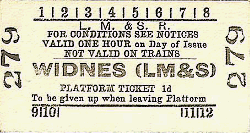 On 18 November 1899 an accident occurred at Widnes station when the 2.40pm departure from Liverpool Lime Street to Manchester London Road ran into an empty wagon train that was running from Garston to the St Helens line resulting in injuries to railway employees and four passengers. On 18 November 1899 an accident occurred at Widnes station when the 2.40pm departure from Liverpool Lime Street to Manchester London Road ran into an empty wagon train that was running from Garston to the St Helens line resulting in injuries to railway employees and four passengers.
In 1911 a rail-motor service, which became known locally as the ‘Ditton Dodger’, was introduced on the St Helens line. Twelve trains ran on weekdays in each direction and additional stations were opened. Local traffic running along the main line continued to be buoyant even with the competition from the nearby Widnes Central.
By 1919 the rail-motor was inadequate for the passenger numbers that were using the service and it was replaced with LNWR Webb tank locomotives and coaches equipped to run in push-and-pull mode. The name ’Ditton Dodger’ stuck, and the service was described as such both by local people and railwaymen until it ended.
In 1923 Widnes station became part of the London Midland & Scottish Railway (LMS). Very little changed, and passenger service patterns continued as they had done previously with the York Mail being the only long distance train. In 1948 Widnes station became part of the British Railways (London Midland Region).
On the 16 June 1951 the ‘Ditton Dodger’ service was withdrawn despite much local opposition. It had never been restored to its pre-war levels, and there had been no effort to make the best of potential connections with other services. During the 1950s the York Mail ceased to call at Widnes.
In 1957, or soon after, Widnes station was fitted with BR(LM) totem signs, and there is photographic evidence of one attached to a gas lamp standard - the form of lighting which would remain until the station's closure. These totems were in use for a very short time indeed as on 5 January 1959 the station became ‘Widnes South’ and BR (LM) totem name signs were installed carrying the new name. 'Widnes South' was also displayed on vitreous enamel signs on the entrance building. Farnworth (Widnes) station on the former CLC main line a few miles to the north was renamed ‘Widnes North’ on the day that Widnes became 'Widnes South'. For a brief period in the late 1950s diesel multiple units (DMUs) were introduced on the Ditton Junction and Manchester Oxford Road service, but they were short-lived as by 1960 steam hauled ‘push-and-pull’ sets, which had operated previously, were the norm.
In the summer of 1959 BR(LM) listed a number of stations that it wished to close. Widnes South was one of them. In the summer BR(LM) 1961 timetable the passenger service was shown as withdrawn and the station closed but underneath there was an addition stating that the service was still running. A timetable was published in the back. Permission for the closure must have been withheld after printing of the timetable had begun.
In an article published in the Widnes Weekly News on 3 August 1962 the acting station master Mr McQuire was interviewed and he described Widnes South as having very few passengers. There were a number of railway employee regulars and about half a dozen other passengers using the station each day. Some trains had only two passengers on board. Mr McQuire explained in the article that Widnes South had been the main facility in Widnes for parcels dealing with about 400 each day. This had changed in September 1961 when BR(LM) had opened a regional parcels depot in Liverpool and allthough Widnes South still recieved parcels the volumes were nothing like they had been.
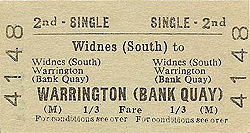 On 10 September 1962 the Ditton and Manchester Oxford Road Service was withdrawn and Widnes South station closed to passengers. Widnes passengers could still travel to Liverpool, Warrington and Manchester from the nearby Widnes Central station, which lasted until October 1964. The York Mail continued to pass through until 1965 but it did not stop. Rugby league specials operated from Widnes South until 1965. The station closed to goods services on 31 March 1969. On 10 September 1962 the Ditton and Manchester Oxford Road Service was withdrawn and Widnes South station closed to passengers. Widnes passengers could still travel to Liverpool, Warrington and Manchester from the nearby Widnes Central station, which lasted until October 1964. The York Mail continued to pass through until 1965 but it did not stop. Rugby league specials operated from Widnes South until 1965. The station closed to goods services on 31 March 1969.
Goods services continued to pass through the station after closure as they still do today. The spur to the St Helens line, however, was closed on 18 April 1982 along with the last sections of that line in Widnes; No.7 signal box closed at the same time.
The platform buildings were demolished within a few years of closure but the roadside building survived until the late 1990s. For many years it was used as a car repair garage. The up platform was intact in 2013, although somewhat overgrown. The down platform had survived intact until 1981 when the eastern half of it was demolished; its western end had gone by 2005.
To see detailed information about the passenger services at Widnes South
click here
To read more about the train crash at Widnes South on
18 November 1899
click here
Tickets by Michael Stewart and route map drawn by Alan Young.
The 8D Association - Dedicated to promoting the history of South Lancashire and North Cheshire railways. Web Site
Sources:
- The St Helens Railway, Its Rivals and Successors – J M Tolston – The Oakwood Press 1982.
- Bradshaw Timetable December 1895.
- Bradshaw Timetable July 1922.
- LMS Timetable Summer 1932.
- BR (LMR) Timetable Summer 1948.
- BR (LMR) Timetable September 1956.
- BR (LMR) Timetable Summer 1962.
- Widnes Weekly News 3 August 1962.
To see other stations on the Garston and Warrington Railway click on the station name: Garston Dock, Church Road, Speke, Halebank, Ditton, Ditton Mill,
Widnes (1st), Cuerdley, Fidlers Ferry, Sankey Bridges,
Warrington Bank Quay Low Level and Warrington Arpley
See also Warrington & Stockport Railway stations: Latchford, Thelwall, Lymm, Dunham Massey and Broadheath
See also St Helens line stations: Ann Street, Appleton, Farnworth & Bold,
Union Bank Farm, Clock Face, Sutton Oak, Peasley Cross, St Helens (1st),
St Helens (2nd) and St Helens (3rd)
See features: The Widnes Deviation Railway and Widnes Locomotive Shed
|

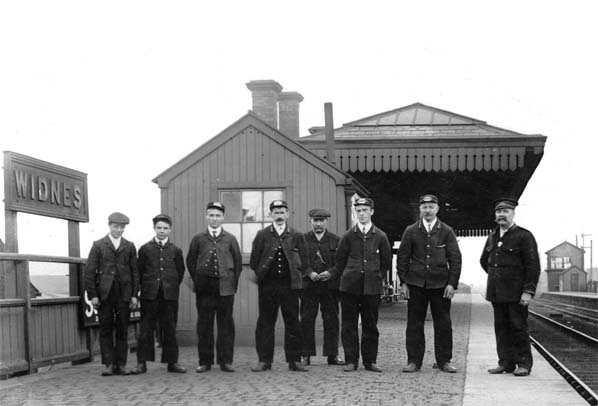
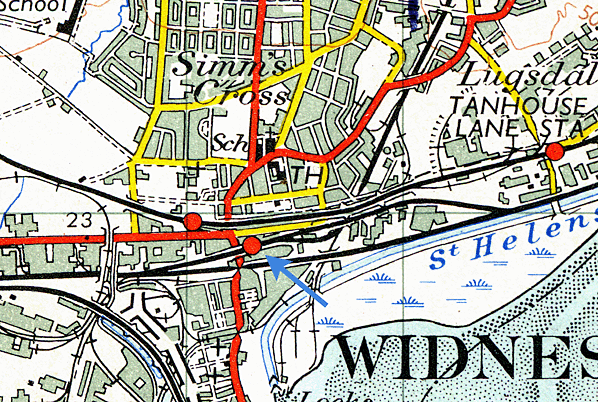
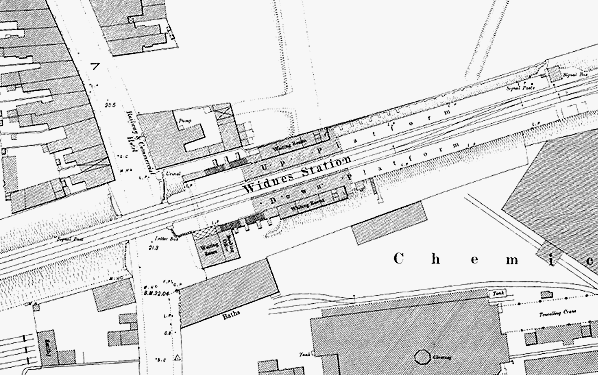
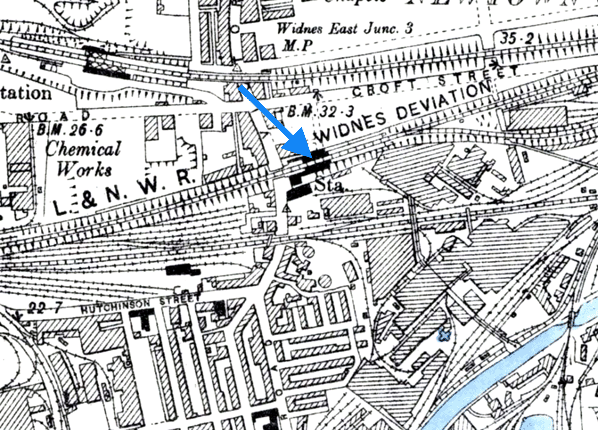
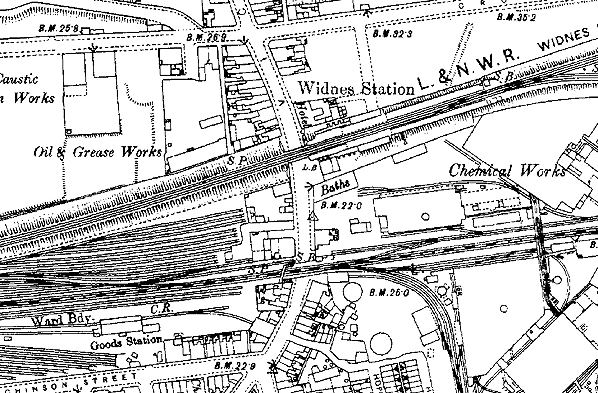
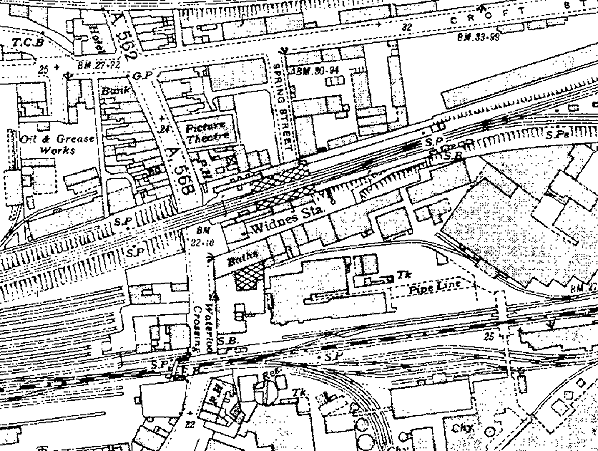
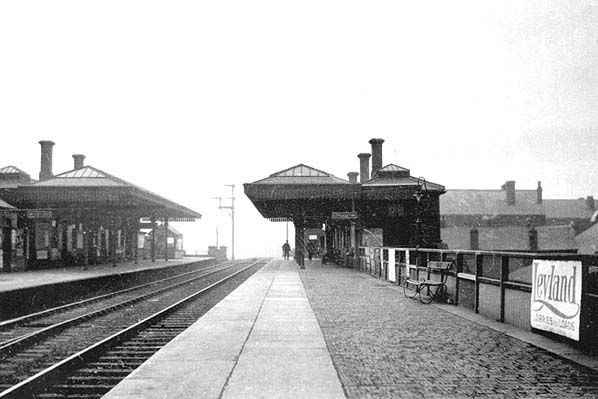
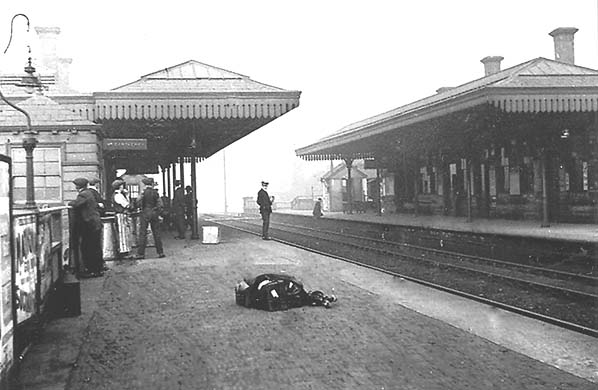
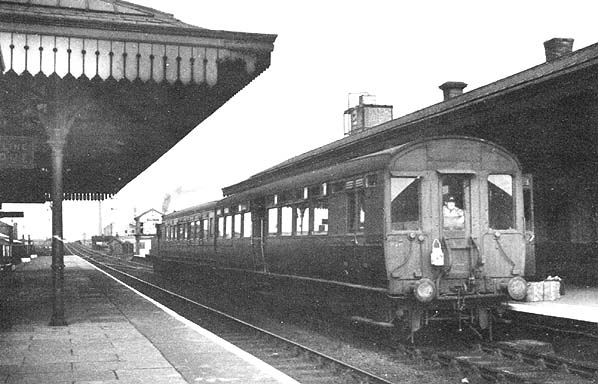
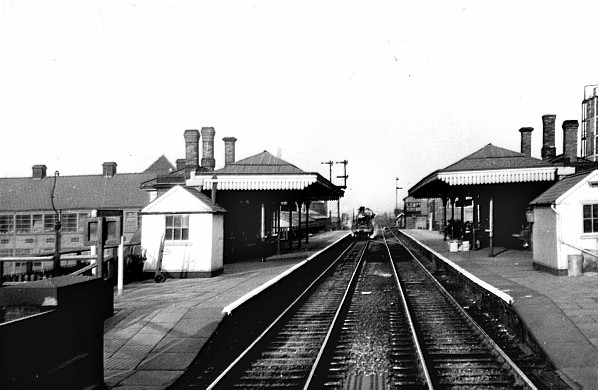
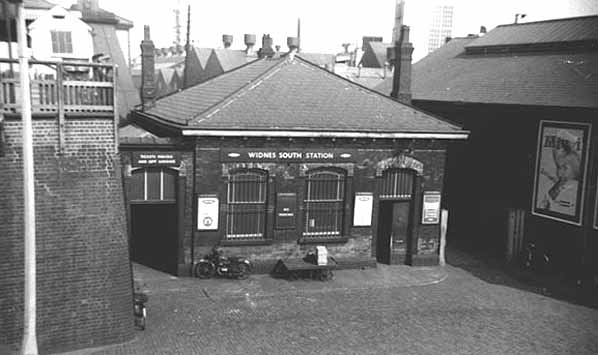
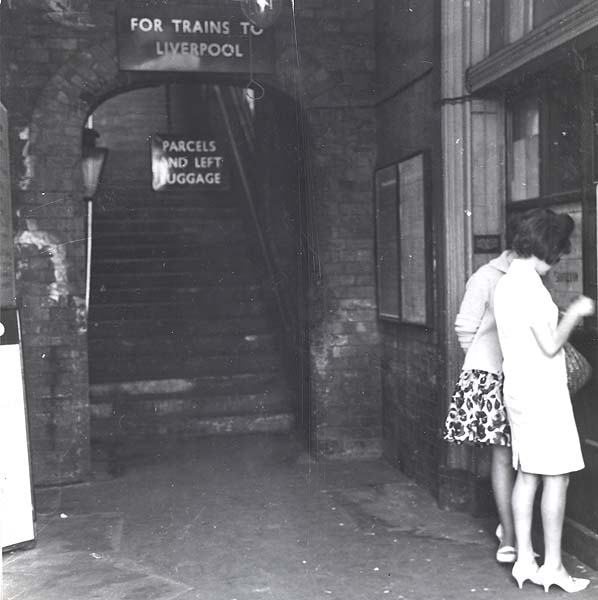

.jpg)
.jpg) Widnes South station looking west in May 2013.
Widnes South station looking west in May 2013.

 Each platform had a single-storey, timber building with a hipped slate roof, which provided waiting facilities for passengers. The buildings directly faced each other and were of similar length. Each had a canopy covering the whole width of the platform and extending to the full length of the building. They were supported by a row of five columns and hipped with a glazed ridge surrounded by a slate skirt and finished off with a valance at each end, but not at the front. There was also a shed on each platform used by station staff for storage. A roadway constructed from granite stone setts connected the eastern end of the down platform to Victoria Road. A barrow crossing at the east end of the station provided access from the roadway to the up platform.
Each platform had a single-storey, timber building with a hipped slate roof, which provided waiting facilities for passengers. The buildings directly faced each other and were of similar length. Each had a canopy covering the whole width of the platform and extending to the full length of the building. They were supported by a row of five columns and hipped with a glazed ridge surrounded by a slate skirt and finished off with a valance at each end, but not at the front. There was also a shed on each platform used by station staff for storage. A roadway constructed from granite stone setts connected the eastern end of the down platform to Victoria Road. A barrow crossing at the east end of the station provided access from the roadway to the up platform.  On 18 November 1899 an accident occurred at Widnes station when the 2.40pm departure from Liverpool Lime Street to Manchester London Road ran into an empty wagon train that was running from Garston to the St Helens line resulting in injuries to railway employees and four passengers.
On 18 November 1899 an accident occurred at Widnes station when the 2.40pm departure from Liverpool Lime Street to Manchester London Road ran into an empty wagon train that was running from Garston to the St Helens line resulting in injuries to railway employees and four passengers.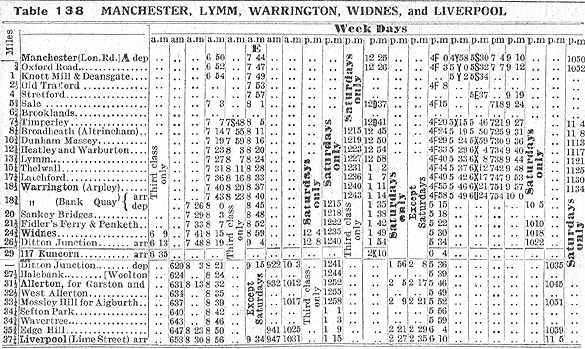
 On 10 September 1962 the Ditton and Manchester Oxford Road Service was withdrawn and Widnes South station closed to passengers. Widnes passengers could still travel to Liverpool, Warrington and Manchester from the nearby Widnes Central station, which lasted until October 1964. The York Mail continued to pass through until 1965 but it did not stop. Rugby league specials operated from Widnes South until 1965. The station closed to goods services on 31 March 1969.
On 10 September 1962 the Ditton and Manchester Oxford Road Service was withdrawn and Widnes South station closed to passengers. Widnes passengers could still travel to Liverpool, Warrington and Manchester from the nearby Widnes Central station, which lasted until October 1964. The York Mail continued to pass through until 1965 but it did not stop. Rugby league specials operated from Widnes South until 1965. The station closed to goods services on 31 March 1969. 
 Home Page
Home Page